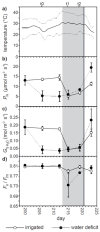The Impact of Heat Stress and Water Deficit on the Photosynthetic and Stomatal Physiology of Olive (Olea europaea L.)-A Case Study of the 2017 Heat Wave
- PMID: 30241389
- PMCID: PMC6313851
- DOI: 10.3390/plants7040076
The Impact of Heat Stress and Water Deficit on the Photosynthetic and Stomatal Physiology of Olive (Olea europaea L.)-A Case Study of the 2017 Heat Wave
Abstract
Heat waves are predicted to increase in frequency and duration in many regions as global temperatures rise. These transient increases in temperature above normal average values will have pronounced impacts upon the photosynthetic and stomatal physiology of plants. During the summer of 2017, much of the Mediterranean experienced a severe heat wave. Here, we report photosynthetic leaf gas exchange and chlorophyll fluorescence parameters of olive (Olea europaea cv. Leccino) grown under water deficit and full irrigation over the course of the heat wave as midday temperatures rose over 40 °C in Central Italy. Heat stress induced a decline in the photosynthetic capacity of the olives consistent with reduced ribulose-1,5-bisphosphate carboxylase/oxygenase (RubisCO) activity. Damage to photosystem II was more apparent in plants subject to water deficit. In contrast to previous studies, higher temperatures induced reductions in stomatal conductance. Heat stress adversely affected the carbon efficiency of olive. The selection of olive varieties with enhanced tolerance to heat stress and/or strategies to mitigate the impact of higher temperatures will become increasingly important in developing sustainable agriculture in the Mediterranean as global temperatures rise.
Keywords: Mediterranean agriculture; OJIP; drought; heat stress; stomatal conductance; water use efficiency.
Conflict of interest statement
The authors declare no conflict of interest.
Figures





References
-
- Intergovernmental Panel on Climate Change (IPCC) Climate Change 2014: Impacts, Adaptation, and Vulnerability. IPCC; Cambridge, UK: 2014. Contribution of Working Group II to the Fifth Assessment Report of the Intergovernmental Panel on Climate Change.
-
- International Olive Council (IOC) World Olive Oil Figures. International Olive Council; Madrid, Spain: 2014.
-
- Teuling A.J. A hot future for European droughts. Nat. Clim. Chang. 2018;8:364–365. doi: 10.1038/s41558-018-0154-5. - DOI
-
- Haworth M., Cosentino S.L., Marino G., Brunetti C., Scordia D., Testa G., Riggi E., Avola G., Loreto F., Centritto M. Physiological responses of Arundo donax ecotypes to drought: A common garden study. GCB Bioenergy. 2017;9:132–143. doi: 10.1111/gcbb.12348. - DOI
Grants and funding
LinkOut - more resources
Full Text Sources
Other Literature Sources

